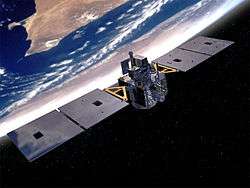MightySat-2.1
| Mission type | Technology |
|---|---|
| Operator | AFRL |
| COSPAR ID | 2000-042A |
| SATCAT no. |
26414 |
| Mission duration | 2 years, 4 months |
| Spacecraft properties | |
| Manufacturer | Orbital ATK |
| Launch mass | 130 kilograms (290 lb) |
| Power | 330 watts |
| Start of mission | |
| Launch date | July 19, 2000 |
| Rocket | Minotaur I |
| Launch site | Vandenberg SLC-8 |
| Contractor | Orbital Sciences |
| End of mission | |
| Decay date | 12 November 2002 |
| Orbital parameters | |
| Reference system | Geocentric |
| Regime | Low Earth |
| Eccentricity | 0.00266 |
| Perigee | 548.0 kilometers (340.5 mi) |
| Apogee | 585.0 kilometers (363.5 mi) |
| Inclination | 97.8 degrees |
| Period | 96.0 minutes |
| Epoch | 19 September 2000, 16:09:00 UTC[1] |
| Instruments | |
| Fourier Transform Hyperspectral Imager | |
MightySat-2.1,[2] also known as P99-1 or Sindri was a small spacecraft developed by the Air Force Research Laboratory[3] to test advanced technologies in imaging, communications, and spacecraft bus components in space.
Design

MightySat II.1 was manufactured by Orbital ATK in a modular approach, using, e.g., VME-based subsystems, and a planar payload deck for small experimental payloads. The satellite measured 0.67m x 0.83m x 0.86m (WxLxH) and had a launch weight of 123.7 kg (Bus Mass: 87.1 kg). Power was provided by 2-axis articulated Si solar arrays with a designed end-of-life power output of 330 W. The attitude determination and control subsystem featured a 3-axis zero-momentum-bias reaction wheel assembly with a Sun sensor, a star tracker and inertial measurement units, delivering an attitude jitter of 15.7 arcsec/sec, and pointing accuracy and knowledge of 648 and 540 arcsec, respectively. The communication was compatible with the US Air Force space-ground link system with data rates of 1 Mbit/s for payload/experiments data downlink, 2.0 kbit/s for command uplink, and 20 kbit/s for telemetry downlink. Computing and data handling was done by a RAD6000 CPU @ 20 MIPS with an IEEE VME backplane 128 MByte CPU RAM, and a 21.6 MBytes/sec transfer rate, and a 2 Gbit solid state recorder for science data. Among its 10 experiments was a Fourier transform hyperspectral imager.[4]
Mission
MightSat II.1 was launched on July 19, 2000 with a Minotaur I. It deorbited in November 2002 due to natural decay of its orbit, exceeding more than twice its nominal lifetime.[4]
Payload and experimental instruments[4]
Stand-alone experiments/sensors
- Kestrel Fourier transform (visible) hyperspectral imager
- Quad TMS320C40 (QC40) floating point digital signal processor
- DARPA-Aerospace sponsored PicoSat launcher assembly
- Shape memory alloy thermoelastic tailoring experiment
- Starfire optical reflectors for use with Kirtland’s Starfire Optical Range
Engineering/experimental bus components
- NRL miniature SGLS transponder (known as the NSX)
- Multi-functional composite bus structure
- Solar array concentrator
- Advanced composite solar array substrate
- Solar array flexible interconnect
References
- ↑ "NASA - NSSDCA - Spacecraft - Trajectory Details". nssdc.gsfc.nasa.gov. Retrieved 2018-05-02.
- ↑ Krebs, Gunter. "Mightysat-2 (P99-1)". Gunter's Space Page. Retrieved 10 July 2013.
- ↑ "MightySat II.1 Datasheet" (PDF). General Dynamics. Archived from the original (PDF) on 2007-10-20. Retrieved 2008-08-01.
- 1 2 3 "MightySat II.1: a standard-interface demonstration smallsat" (PDF). General Dynamics. 2005-11-05. Retrieved 2010-12-22.